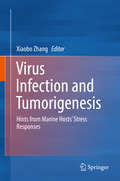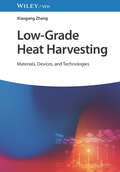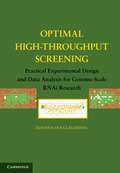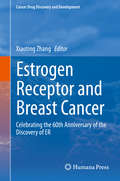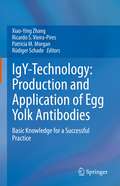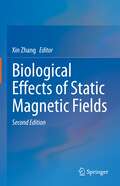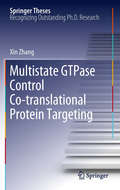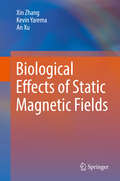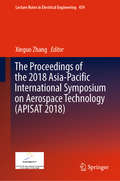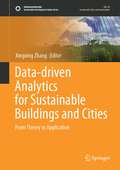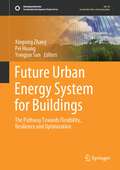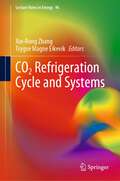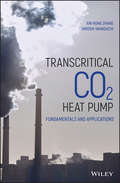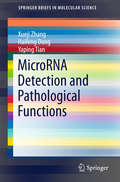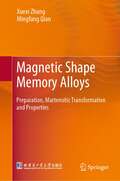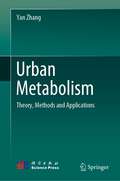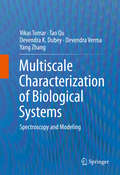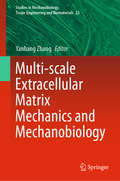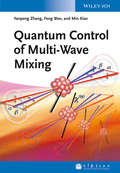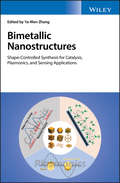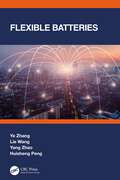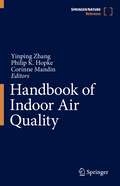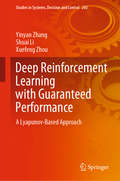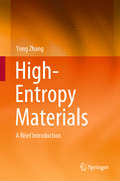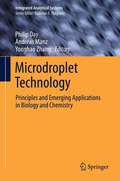- Table View
- List View
Virus Infection and Tumorigenesis: Hints from Marine Hosts’ Stress Responses
by Xiaobo ZhangThis book reviews the latest research on the molecules and mechanisms of marine host stress responses to viral infections and tumorigenesis. It offers an overview of the state of the art in the field as well as future directions. Metabolism disorder is a characteristic of tumorigenesis. Since viruses complete their life cycle in host cells, such infections cause metabolic disorders in the host. As such, the mechanisms of virus pathogenesis and tumor progression are similar or even identical. In essence, the role of antiviral molecules is to maintain the metabolic homeostasis of infected host cells, and the antiviral molecules induced by virus infection may play an important role in antitumor pathways, resulting in cancer cell death or restoring the disordered metabolism of cancer cells. The molecules generated during host stress responses to viruses can also contribute to the antitumor mechanisms in humans. However, the relationship between host stress responses to virus infection and tumorigenesis has not been extensively explored. In recent years, studies have shown that marine host stress responses to viral invasion can be good models for exploring human antitumor mechanisms. Stimulating further research in the field, this book offers graduate students and researchers with comprehensive insights into host stress responses to viral invasion and tumor progression. It is also a valuable resource for those working in the pharmaceutical industry interested in drug discovery based on molecules derived from host stress responses to viral infection.
Low-Grade Heat Harvesting: Materials, Devices, and Technologies
by Xiaogang ZhangLow-Grade Heat Harvesting Harvest a vast untapped reservoir of energy with this essential resource The search for widely available, sustainable energy sources is arguably the defining challenge of the current era. Low-Grade Heat, a term referring to temperatures under 100 degrees Celsius, is an incredibly abundant form of energy in the natural world, but not one which existing sustainable technologies have been able to harvest efficiently and sustainably. The ubiquity of this energy, however, gives it huge potential to address the looming energy crisis. Low-Grade Heat Harvesting surveys existing technologies for utilizing low-grade heat and the related techniques for storing and converting low-grade heat energy. Beginning with the basic thermodynamic principles underlying low-grade heat, it proceeds to work systematically through the major categories of low-grade heat harvesting device, offering a comprehensive overview of the state of the field. Low-Grade Heat Harvesting readers will also find: A focus on emerging technologies Detailed discussion of thermoelectric devices for low-grade heat harvesting, liquid-based thermocells for heat-to-current conversion, and many more Authored by an acknowledged expert in energy storage and conversion Low-Grade Heat Harvesting is ideal for materials scientists, electrochemists, electronics engineers, and anyone else working to address energy needs.
Optimal High-Throughput Screening
by Xiaohua Douglas ZhangThis concise, self-contained and cohesive book focuses on commonly used and recently developed methods for designing and analyzing high-throughput screening (HTS) experiments from a statistically sound basis. Combining ideas from biology, computing and statistics, the author explains experimental designs and analytic methods that are amenable to rigorous analysis and interpretation of RNAi HTS experiments. The opening chapters are carefully presented to be accessible both to biologists with training only in basic statistics and to computational scientists and statisticians with basic biological knowledge. Biologists will see how new experiment designs and rudimentary data-handling strategies for RNAi HTS experiments can improve their results, whereas analysts will learn how to apply recently developed statistical methods to interpret HTS experiments.
Estrogen Receptor and Breast Cancer: Celebrating the 60th Anniversary of the Discovery of ER (Cancer Drug Discovery and Development)
by Xiaoting ZhangThe discovery of ER by Dr. Elwood Jensen exactly 60 years ago has not only led to the birth of a whole new vital nuclear receptor research field but also made a rapid, direct and lasting impact on the treatment and prevention of breast cancer. Since that landmark discovery, tremendous progress has been made in our understanding of the molecular functions of ER and development of targeted therapies against ER pathways for breast cancer treatment. However, there is currently no book available addressing these discoveries and recent advancement in a historical and systematic fashion. This book is intended to provide comprehensive, most up-to-date information on the history and recent advancement of ER and breast cancer by world renowned leaders in the field. These chapters include the history of the discovery of ER; physiological and pathological roles of ER; recent discovery of ER cistrome, transcriptome and its regulation of noncoding RNAs such as microRNAs and enhancer RNAs in breast cancer; development and clinical practices of the first targeted therapy Tamoxifen and other antiestrogens for breast cancer treatment; structural basis of ER and antiestrogen actions; molecular insights into endocrine resistance; the role of ER mutants, ER-beta and environmental estrogens in breast cancer; and emerging state-of-the-art therapeutic approaches currently in development to overcome treatment resistance and future perspectives. The book will provide undergraduate and graduate students, basic scientists and clinical cancer researchers, residents, fellows, as well as clinicians, oncology educators and the general public a thorough and authoritative review of these exciting topics.
IgY-Technology: Basic Knowledge for a Successful Practice
by Xiao-Ying Zhang Ricardo S. Vieira-Pires Patricia M. Morgan Rüdiger SchadeThis first edited Volume on IgY-Technology, addresses the historical and dynamic development of IgY-applications. The authors cover the biological basis and theoretical context, methodological guidance, and applications of IgY-Technology. A focus is laid on the use of IgY-antibodies for prophylactic/therapeutic purposes in human and veterinary medicine. Aside from applications, the chapters also offer an evolutionary understanding of the IgY molecule, IgY receptors and practical prerequisites to produce IgY-antibodies. Guidance is given for every step of the process. Starting with an introduction to hens as a model species and including hen husbandry, hen egg-laying capacity and total IgY outcomes. Readers will also learn about immunization techniques, the advantages and limitations of different IgY extraction methods, as well as storage stability of the final product. The last part of the volume highlights hands-on aspects of applications, such as IgY delivery strategies, new methods to produce monoclonal IgY-antibodies or production of functional IgY fragments by phage-display as well as commercial exploitation of the technology. Thus, this book is a valuable resource and guide for Scientists, Clinicians and Health Product Developers in both human and veterinary medicine.
Biological Effects of Static Magnetic Fields
by Xin ZhangThe book summarizes the emerging topic about the effects of SMF on biological samples ranging from single molecules, subcellular compartments, and cells to whole organisms. It also discusses the potential application of SMF in clinical treatment of cancer, pain, diabetes and other diseases.With the development and growing popularity of modern appliances like MRI in hospitals, the potential impact of magnetic fields on human health is invoking increasing concerns. At the same time, SMF has been explored in the treatment of tumor and other diseases for decades. Nevertheless, there are still some reservations and uncertainties about these treatments, which are largely due to the differential biological effects reported in the literature. These experimental inconsistencies are mainly caused by variations such as different magnetic field types, intensities, treatment time, as well as biological samples examined. The second edition added eight new chapters about new progress in this field including impacts of SMFs, magnetism of biomolecules, and potential of SMFs in the management of bone, pain, diabetes, and immune systems. This volume will help clarify some dilemmas in this field and encourage further investigations in order to achieve a better understanding of the biological effects of SMF, aiming for a rational application of SMF in clinical therapy in the near future. The book is useful for scientists, doctors, and students who are interested in magnetic fields and life sciences
Multistate GTPase Control Co-translational Protein Targeting
by Xin ZhangProteins act as macromolecular machinery that mediate many diverse biological processes - the molecular mechanisms of this machinery has fascinated biologists for decades. Analysis of the kinetic and thermodynamic features of these mechanisms could reveal unprecedented aspects of how the machinery function and will eventually lead to a novel understanding of various biological processes. This dissertation comprehensively demonstrates how two universally conserved guanosine triphosphatases in the signal recognition particle and its membrane receptor maintain the efficiency and fidelity of the co-translational protein targeting process essential to all cells. A series of quantitative experiments reveal that the highly ordered and coordinated conformational states of the machinery are the key to their regulatory function. This dissertation also offers a mechanistic view of another fascinating system in which multistate protein machinery closely control critical biological processes. Written while completing graduate work at California Institute of Technology.
Biological Effects of Static Magnetic Fields
by Xin Zhang Kevin Yarema An XuThe book summarize the emerging topic about the effects of SMF on biological samples ranging from single molecules, subcellular compartments, and cells to whole organisms, as well as the potential application of SMF in clinical treatment of cancer and other diseases. With the development and growing popularity of modern appliances, including MRI in the hospitals, the potential impact of magnetic fields on human health is invoking increasing concerns. At the same time, static magnetic field (SMF) has been used in the clinical treatment of tumors and other diseases for decades. However, there are still some reservations and uncertainties about these treatments, which are largely due to the differential biological effects reported in the literature. These experimental inconsistencies are mainly caused by variations such as different magnetic field types, intensities, treatment time as well as biological samples examined. This volume will help clarify some dilemmas in this field and encourage further investigation in order to achieve a better understanding of the biological effects of SMF, aiming for a rational application of SMF in clinical therapy in the near future. The book is useful for scientists and students in static magnetic field and clinical doctors et cl.
The Proceedings of the 2018 Asia-Pacific International Symposium on Aerospace Technology (Lecture Notes in Electrical Engineering #459)
by Xinguo ZhangThis book is a compilation of peer-reviewed papers from the 2018 Asia-Pacific International Symposium on Aerospace Technology (APISAT 2018). The symposium is a common endeavour between the four national aerospace societies in China, Australia, Korea and Japan, namely, the Chinese Society of Aeronautics and Astronautics (CSAA), Royal Aeronautical Society Australian Division (RAeS Australian Division), the Korean Society for Aeronautical and Space Sciences (KSAS) and the Japan Society for Aeronautical and Space Sciences (JSASS). APISAT is an annual event initiated in 2009 to provide an opportunity for researchers and engineers from Asia-Pacific countries to discuss current and future advanced topics in aeronautical and space engineering.
Data-driven Analytics for Sustainable Buildings and Cities: From Theory to Application (Sustainable Development Goals Series)
by Xingxing ZhangThis book explores the interdisciplinary and transdisciplinary fields of energy systems, occupant behavior, thermal comfort, air quality and economic modelling across levels of building, communities and cities, through various data analytical approaches. It highlights the complex interplay of heating/cooling, ventilation and power systems in different processes, such as design, renovation and operation, for buildings, communities and cities. Methods from classical statistics, machine learning and artificial intelligence are applied into analyses for different building/urban components and systems. Knowledge from this book assists to accelerate sustainability of the society, which would contribute to a prospective improvement through data analysis in the liveability of both built and urban environment. This book targets a broad readership with specific experience and knowledge in data analysis, energy system, built environment and urban planning. As such, it appeals to researchers, graduate students, data scientists, engineers, consultants, urban scientists, investors and policymakers, with interests in energy flexibility, building/city resilience and climate neutrality.
Future Urban Energy System for Buildings: The Pathway Towards Flexibility, Resilience and Optimization (Sustainable Development Goals Series)
by Xingxing Zhang Pei Huang Yongjun SunThis book investigates three main characteristics of future urban energy system for buildings, including flexibility, resilience and optimization. It explores the energy flexibility by considering renewable energy integration with buildings, sector coupling, and energy trading in the local energy market. Energy resilience is addressed from aspects of future climate change, pandemic crisis, and operational uncertainties. Approaches for system design, dynamic pricing and advanced control are discussed for the optimization of urban energy system. Knowledge from this book contributes to the effective means in future urban energy paradigm to closely integrate multiple energy systems (i.e., distribution, mobility, production and storage) with different energy carriers (i.e., heat, electricity) in an optimal manner for energy use. It would facilitate the envision of next-generation urban energy systems, towards sustainability, resilience and prosperity. This book targets at a broad readership with specific experience and knowledge in energy system, transport, built environment and urban planning. As such, it will appeal to researchers, graduate students, engineers, consultants, urban scientists, investors and policymakers, with interests in energy flexibility, building/city resilience and climate neutrality.
CO2 Refrigeration Cycle and Systems (Lecture Notes in Energy #96)
by Xin-Rong Zhang Trygve Magne EikevikThis book covers the fundamentals and applications of carbon dioxide vapor compression refrigeration thermodynamic cycles. In particular, it presents new application areas, such as making ice and snow in the Winter Olympic Games, food cooling and refrigeration. The book explores the physical and chemical characteristics of CO2 fluid, and the unique traits of its thermodynamic cycle. The contributors explain how CO2 refrigeration is a developing, eco-friendly technology, and emphasize its importance for refrigeration and air-conditioning in the current and future market.This book is a valuable source of information for researchers, engineers and policy makers looking to expand their applicable knowledge of high-potential refrigeration technology using carbon dioxide. It is also of interest to postgraduate students and practitioners looking for an academic insight into the industry’s latest eco-friendly technologies.
Transcritical CO2 Heat Pump: Fundamentals and Applications
by Xin-rong Zhang Hiroshi YamaguchiA timely and comprehensive introduction to CO2 heat pump theory and usage A comprehensive introduction of CO2 application in heat pump, authored by leading scientists in the field CO2 is a hot topic due to concerns over global warming and the 'greenhouse effect'. Its disposal and application has attracted considerable research and governmental interest Explores the basic theories, devices, systems and cycles and real application designs for varying applications, ensuring comprehensive coverage of a current topic CO2 heat transfer has everyday applications including water heaters, air-conditioning systems, residential and commercial heating systems, and cooling systems
MicroRNA Detection and Pathological Functions
by Xueji Zhang Haifeng Dong Yaping TianThis book summarizes microRNA (miRNA) biology in a variety of pathological processes, emphasizing the significant potential applications of miRNA in diagnostics and prognostics, as well as novel drug targets. The conventional techniques used for miRNA detection including standard PCR, Northern blotting, microarray and clone methods are addressed. Recent emerging strategies in miRNA detection and quantification with superior flexibility and adaptability, such as novel molecular biological techniques and locked nucleic acid (LNA) modified probes, as well as nanotechnology-based approaches, are also included. The book also highlights the latest advances in clinical-related miRNA detection methods in living cells, circulating blood and tissue, such as in situ hybridization (ISH) and molecular imaging techniques, which are useful to elucidate the biogenesis and biological function of miRNAs in vivo. Finally, the respective advantages and drawbacks of various detection techniques in this fast-moving field are discussed, along with the challenges and promising new directions. This book offers a valuable resource for analytical chemists, biologists and physicians involved in miRNA research. Dr. Xueji Zhang and Dr. Haifeng Dong are Professors at the School of Chemistry & Biological Engineering, University of Science & Technology Beijing (USTB), China. Dr. Yaping Tian is a Professor at the Department of Clinical Biochemistry, Chinese PLA General Hospital and Military Medical School, China.
Magnetic Shape Memory Alloys: Preparation, Martensitic Transformation and Properties
by Xuexi Zhang Mingfang QianThis book systematically describes the fundamentals of Magnetic shape memory alloys (MSMAs), with an emphasis on low-dimensional structures such as foams, microwires and micro-particles. The respective chapters address basic concepts and theories, the fabrication of various architectures, microstructure tailoring, property optimization and cutting-edge applications. Taken together, they provide a clear understanding of the correlation between processing and the microstructural properties of MSMAs, which are illustrated in over two hundred figures and schematics. Given its scope and format, the book offers a valuable resource for a broad readership in various fields of materials science and engineering, especially for researchers, students and engineers.
Urban Metabolism: Theory, Methods and Applications
by Yan ZhangThis book provides the basic theory, method framework and application results of urban metabolism. Urban metabolism is an important research philosophy and approach for analyzing urban mega organism and its ecological environmental problems. It has constantly formed quantitative network research framework and analysis methods in a metaphor way and expanded its application in different scales such as global, national, urban agglomeration and city to support the process of multi-scale regional sustainable development.
Multiscale Characterization of Biological Systems
by Yang Zhang Devendra Verma Devendra K. Dubey Tao Qu Vikas TomarThis book covers the latest research work done in the area of interface mechanics of collagen and chitin-based biomaterials along with various techniques that can be used to understand mechanics of biological systems and materials. Topics covered include Raman spectroscopy of biological systems, scale dependence of the mechanical properties and microstructure of crustaceans thin films as biomimetic materials, as well as the role of molecular-level modeling. The use of nanomechanics to investigate interface thermomechanics of collagen and chitin-based biomaterials is also covered in detail. This book also: * Details spectroscope experiments as well as nanomechanic experiments * Reviews exhaustively phenomenological models and Raman spectroscopy of biological systems * Covers the latest in multiscaling for molecular models to predict lab-scale sample properties and investigates interface thermomechanics
Multi-scale Extracellular Matrix Mechanics and Mechanobiology (Studies in Mechanobiology, Tissue Engineering and Biomaterials #23)
by Yanhang ZhangThis book describes the current state of knowledge in the field of multi-scale ECM mechanics and mechanobiology with a focus on experimental and modelling studies in biomechanical characterization, advanced optical microscopy and imaging, as well as computational modeling. This book also discusses the scale dependency of ECM mechanics, translation of mechanical forces from tissue to cellular level, and advances and challenges in improving our understanding of cellular mechanotransduction in the context of living tissues and organisms.
Quantum Control of Multi-Wave Mixing
by Yanpeng Zhang Feng Wen Min XiaoMulti-wave mixing gives rise to new frequency components due to the interaction of light signals with a suitable nonlinear medium. <P><P>In this book a systematic framework for the control of these processes is used to lead readers through a plethora of related effects and techniques.
Bimetallic Nanostructures: Shape-Controlled Synthesis for Catalysis, Plasmonics, and Sensing Applications
by Ya-Wen ZhangSystematically summarizes the current status and recent advances in bimetallic structures, their shape-controlled synthesis, properties, and applications Intensive researches are currently being carried out on bimetallic nanostructures, focusing on a number of fundamental, physical, and chemical questions regarding their synthesis and properties. This book presents a systematic and comprehensive summary of the current status and recent advances in this field, supporting readers in the synthesis of model bimetallic nanoparticles, and the exploration and interpretation of their properties. Bimetallic Nanostructures: Shape-Controlled Synthesis for Catalysis, Plasmonics and Sensing Applications is divided into three parts. Part 1 introduces basic chemical and physical knowledge of bimetallic structures, including fundamentals, computational models, and in situ characterization techniques. Part 2 summarizes recent developments in synthetic methods, characterization, and properties of bimetallic structures from the perspective of morphology effect, including zero-dimensional nanomaterials, one-dimensional nanomaterials, and two-dimensional nanomaterials. Part 3 discusses applications in electrocatalysis, heterogeneous catalysis, plasmonics and sensing. Comprehensive reference for an important multidisciplinary research field Thoroughly summarizes the present state and latest developments in bimetallic structures Helps researchers find optimal synthetic methods and explore new phenomena in surface science and synthetic chemistry of bimetallic nanostructures Bimetallic Nanostructures: Shape-Controlled Synthesis for Catalysis, Plasmonics and Sensing Applications is an excellent source or reference for researchers and advanced students. Academic researchers in nanoscience, nanocatalysis, and surface plasmonics, and those working in industry in areas involving nanotechnology, catalysis and optoelectronics, will find this book of interest.
Flexible Batteries
by Ye Zhang Lie Wang Yang Zhao Huisheng PengFlexible Batteries highlights the key advances in flexible batteries, a booming new direction in the energy storage field. The authors first introduce lithium-ion batteries, which are currently the most widely used batteries. Flexible aqueous batteries such as aqueous lithium-ion, sodium-ion, and zinc-ion batteries are discussed subsequently due to the safety concerns in organic electrolytes. Since flexible metal-air batteries are recognized as primary choices for the next generation, the authors take lithium-air and aluminum-air batteries as examples to explore their applications in flexible battery construction. They further summarize flexible batteries under the most challenging working conditions such as stretching and integrating flexible batteries with flexible energy harvesting devices, sensors, and supercapacitors. Covering both fundamental and application development, this book may effectively bridge academics and industry. It will be helpful not only to scholars and students studying materials science and engineering, chemical engineering, physics, energy science, and biomedical science but also to scientists and engineers in the industry.
Handbook of Indoor Air Quality
by Yinping Zhang Philip K. Hopke Corinne MandinPeople live in indoor environment about 90% of lifetime and an adult inhales about 15 kg air each day, over 75% of the human body’s daily mass intake (air, food, water). Therefore, indoor air quality (IAQ) is very important to human health. This book provides the basic knowledge of IAQ and highlights the research achievements in the past two decades. It covers the following 12 sections: introduction, indoor air chemicals, indoor air particles, measurement and evaluation, source/sink characteristics, indoor chemistry, human exposure to indoor pollutants, health effects and health risk assessment, IAQ and cognitive performance, standards and guidelines, IAQ control, and air quality in various indoor environments. It provides a combination of an introduction to various aspects on IAQ studies, the current state-of-knowledge, various advances and the perspective of IAQ studies. It will be very helpful for the researchers and technicians in the IAQ and the related fields. It is also useful for experts in other fields and general readers who want to obtain a basic understanding of and research advances in the field of IAQ.A group of experts in IAQ research have been recruited to write the chapters. Their research interests and experience cover the scope of the book. In addition, some experienced experts in IAQ field have been invited as advisors or reviewers to give their comments, suggestions and revisions on the handbook framework and the chapter details. Their contribution guarantees the quality of the book. We are very grateful to them. Last but not least, we express our heartfelt thanks to Prof. Spengler, Harvard University, for writing the foreword of the current Handbook of Indoor Air Quality both as a pioneer scientist who contributed greatly to indoor air science and as an Editor-in-chief of Handbook of Indoor Air Quality 2001, 1st ed. New York: McGraw-Hill. In addition to hard copies, the book is also published online and will be updated by the authors as needed to keep it aligned with current knowledge. These salient features can make the handbook fresh with the research development.
Deep Reinforcement Learning with Guaranteed Performance: A Lyapunov-Based Approach (Studies in Systems, Decision and Control #265)
by Yinyan Zhang Shuai Li Xuefeng ZhouThis book discusses methods and algorithms for the near-optimal adaptive control of nonlinear systems, including the corresponding theoretical analysis and simulative examples, and presents two innovative methods for the redundancy resolution of redundant manipulators with consideration of parameter uncertainty and periodic disturbances.It also reports on a series of systematic investigations on a near-optimal adaptive control method based on the Taylor expansion, neural networks, estimator design approaches, and the idea of sliding mode control, focusing on the tracking control problem of nonlinear systems under different scenarios. The book culminates with a presentation of two new redundancy resolution methods; one addresses adaptive kinematic control of redundant manipulators, and the other centers on the effect of periodic input disturbance on redundancy resolution.Each self-contained chapter is clearly written, making the book accessible to graduate students as well as academic and industrial researchers in the fields of adaptive and optimal control, robotics, and dynamic neural networks.
High-Entropy Materials: A Brief Introduction
by Yong ZhangThis book draws on the latest research to discuss the history and development of high-entropy alloys and ceramics in bulk, film, and fiber form. High-entropy materials have recently been developed using the entropy of mixing and entropy of configuration of materials, and have proven to exhibit unique properties superior to those of conventional materials. The field of high-entropy alloys was born in 2004, and has since been developed for both scientific and engineering applications. Although there is extensive literature, this field is rapidly transforming. This book highlights the cutting edge of high-entropy materials, including their fundamentals and applications. Above all, it reflects two major milestones in their development: the equi-atomic ratio single-phase high-entropy alloys; and the non-equi-atomic ratio dual-phase high-entropy alloys.
Microdroplet Technology
by Yonghao Zhang Philip Day Andreas ManzMicrodroplet technology has recently emerged to provide new and diverse applications via microfluidic functionality, especially in various areas of biology and chemistry. This book, then, gives an overview of the principle components and wide-ranging applications for state-of-the-art of droplet-based microfluidics. Chapter authors are internationally-leading researchers from chemistry, biology, physics and engineering that present various key aspects of micrdroplet technology -- fundamental flow physics, methodology and components for flow control, applications in biology and chemistry, and a discussion of future perspectives. This book acts as a reference for academics, post-graduate students, and researcher wishing to deepen their understand of microfluidics and introduce optimal design and operation of new droplet-based microfluidic devices for more comprehensive analyte assessments.
